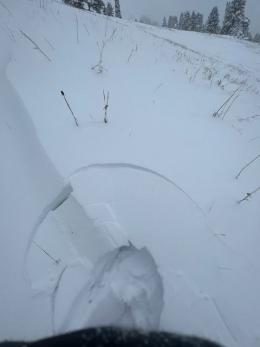This is Dave Zinn with pre-season avalanche, weather and event information for the Gallatin National Forest Avalanche Center on Monday, October 24th. This information is sponsored by The Friends of the Avalanche Center. Join them in supporting free and low-cost avalanche education, community outreach and avalanche center operations during the 2022 Virtual Powder Blast.
This weekend, rain turned to snow across the advisory area and the ranges near Bozeman and Big Sky received 20-30” of new snow and 10” near West Yellowstone and Cooke City. The first half of the week will bring 20-35 MPH winds from the northwest to the southwest. The Cooke City and West Yellowstone areas will get 3-7” of snow by Thursday morning with lighter accumulation in the mountains near Bozeman and Big Sky. Mountain temperatures will remain in the 20s to mid-30s F through the week.
For current weather data, check our weather stations in Cooke City, Hyalite, Lionhead and on Sawtelle Peak near Island Park, ID. Also, utilize the ski area weather stations from Big Sky, Bridger Bowl and Yellowstone Club, and SNOTEL sites throughout our advisory area. We will update the Weather and Avalanche Log daily and issue pre-season bulletins as needed.
And, just like that, it is winter and avalanche season is here. We received our first observations yesterday from the Bridger Range and the first indicators of unstable snow with it. While the reported drift was small and isolated, similar drifts will be larger and more consequential in areas with more snow and/ or exposed to more wind (photo and details). This week, avalanches are most likely in steep terrain where the wind loads the new snow into thick drifts. The forecasted 20-35 MPH winds early in the week will exacerbate this problem.
Early-season avalanches have seriously injured and buried skiers (2012 Incident Report), caught and injured hunters (2015 Incident Report), and resulted in tragic fatalities (2017 Incident Report). These reports serve as reminders to EITHER avoid steep snow-covered slopes OR follow avalanche safety protocols by having a partner, backing out of steep terrain when signs of instability present themselves, traveling one at a time in terrain steeper than 30 degrees, and carrying rescue gear that you practice using (avalanche beacon, shovel, and probe). These rules apply whether you are making snow angels, hunting, sneaking in the last hike, or searching for early-season turns.
Before heading out for the first time this season, do three things.
- Assess the condition of your gear… it didn’t fix itself over the summer (how to video)
- Practice your avalanche rescue with your friends and backcountry partners (beacon drill video)
- Look at our avalanche education calendar and plan to develop your skills further this year
Your observations are more important than ever during the early season as we get to know this season’s snowpack. If you get out, please share avalanche, snowpack or weather observations via our website, email (mtavalanche@gmail.com), phone (406-587-6984), or Instagram (#gnfacobs). NEW THIS YEAR is a page on the website populated with your observations (you must opt-in for observations to be shared publically).
We’ll be updating the Weather and Avalanche Log daily and issuing pre-season bulletins as needed throughout the fall as conditions warrant.
This weekend’s storm delivered 20 near Island Park. You are most likely to trigger an avalanche in steep terrain where the wind is loading the snow into thick drifts. Strong winds early this week will exacerbate this problem. EITHER avoid steep snow-covered slopes OR follow avalanche safety protocols by having a partner, backing out of steep terrain when signs of instability present themselves, traveling one at a time in terrain steeper than 30 degrees, and carrying avalanche rescue gear.
Upcoming Avalanche Education and Events
Our education calendar is full of awareness lectures and field courses. Check it out: Events and Education Calendar.
This Wednesday, October 26, is the MSU Snow and Avalanche Workshop from 4:30-8:30 p.m. Dave Zinn and Ian Hoyer will be giving talks along with our Education Coordinator Shannon Regan. You can attend in person or virtually.
The Utah Avalanche Center Snow and Avalanche Workshop is a great online opportunity from 6-9 PM on November 2 and 9.
We are offering an Avalanche Fundamentals with Field Session course for skiers in December and January, and snowmobilers in early January. Sign up early before they fill up.
Friends of GNFAC Powder Blast Fundraiser
The Friends of the Avalanche Center are hosting the Virtual Powder Blast fundraiser. Your donations support free and low-cost avalanche education, beacon checkers at trailheads, beacon parks, weather stations, and GNFAC programs! The Friends of GNFAC launched an online GoFundMe campaign. Please consider a donation, and we look forward to having an in-person event again in the future.
If you’re headed out hunting in the coming days, read this article Alex wrote on avalanche avoidance for hunters. If you’re thinking about skiing or riding, this accident report from October 2012 in the northern Bridger Range contains good lessons for how things can go wrong when searching for early-season turns.


